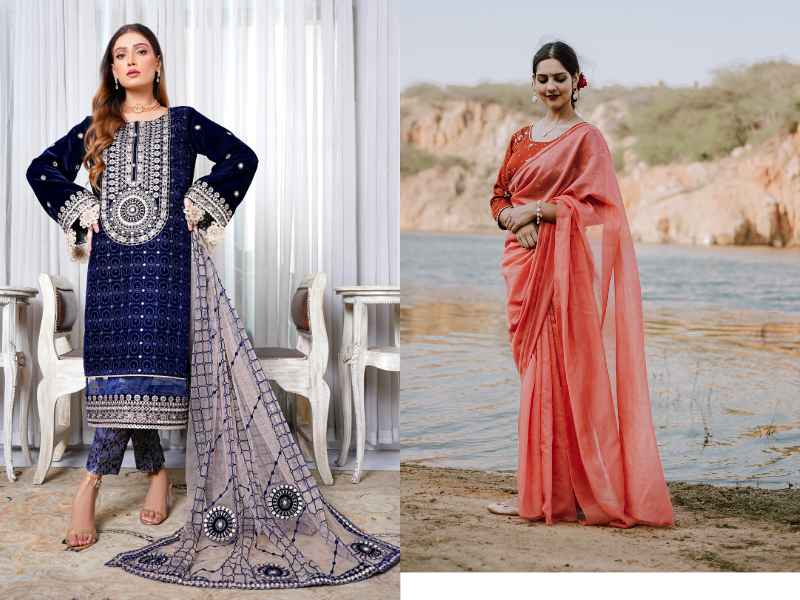With trends in this world fleeting faster than you can say “fashion,” ethnic wear is a time-tested, deep-rooted reflection of culture, tradition, and heritage. From the majestic sherwanis of North India to the vibrant saris of South India, ethnic clothing is not just attire t’s a celebration of heritage, a gesture towards our roots, and in many cases, a visual chronicle passed down through generations.
But what, precisely, is ethnic wear? And why is it still so topical in today’s modern, globalized world of fashion? Let’s untangle the universe of ethnic fashion and discover why it remains so close to our hearts and wardrobes.

Understanding Ethnic Wear: More Than Just Traditional Clothing
Fundamentally, ethnic wear is a type of apparel that captures the cultural identity of a certain geographic region or society. It is usually a reflection of history, tradition, climate, and social behavior. In India, for instance, ethnic wear may vary from sarees, lehengas, and kurtas to dhotis, angarakhas, and bandhgalas.
In contrast to western apparel, which follows world fashion trends most of the time, ethnic clothing has a history attached to it whether it is in how it is draped, material used, or the hand embroidery through generations of artisans. Ethnic clothing is wearable art, symbolic but most of the time blended with contemporary elements for this generation.
The Most Loved Ethnic Wear for Women
Let’s begin with the amazing ethnic wear diversity in women’s wear. Indian ethnic fashion itself has an infinite variety of fabric, shape, and purpose. Below are some of the pick of the bunch:
1. Saree
The saree is one of India’s most iconic ethnic clothes. It’s a six to nine-yard-long cloth draped beautifully over the body. It’s versatile, beautiful, and draped differently across regions—ranging from the Bengali to the Maharashtrian nauvari.
2. Salwar Kameez
The salwar kameez is a wardrobe essential for everyday life in most areas of North India, made up of a tunic (kameez), loose trousers (salwar), and a dupatta (scarf). It’s cherished for its practicality and can be anything from basic cottons to designer-embellished ones for weddings.
3. Lehenga Choli
The lehenga choli, which is typically worn for festivals, weddings, and other events, is made up of a long skirt (lehenga), blouse (choli), and dupatta. In the world of ethnic fashion, it’s a show-stopper when adorned with sequins, zardozi, or mirror work.
4. Kurti
A less formal cousin of the kameez, kurtis are shorter tunics with leggings, palazzos, or jeans. They mix and match ethnic beauty with modern styling and are an office favourite, college go-to, or a hangout favourite.

Most Popular Ethnic Wear for Men
Although men’s ethnic dressing may look low-key when compared to women’s, it is no less trendy or important.
1. Kurta Pajama
This classic set includes a knee-length tunic (kurta) and loose itting trousers (pajama). Silk or embroidered kurtas are ideal for celebratory occasions, while basic cotton versions are excellent for everyday use

2.Sherwani
At weddings and other formal occasions, sherwanis long, coat-like garments worn over a kurta and churidar are commonly worn. Rich fabrics like silk and brocade, paired with ornate buttons and stoles, make it a regal choice.
3.Nehru Jacket
Named after India’s first Prime Minister, the Nehru jacket is a sleeveless, tailored coat that gives kurtas a touch of formality. It’s an intelligent means of dressing up even the most basic outfit.
4. Dhoti and Lungi
Although dressed more traditionally in rural or regional communities, dhotis and lungis remain topical today, particularly for religious or ceremonial occasions. They provide a cultural character you just can’t achieve with western trousers.
Why Ethnic Wear Still Matters
It’s Culturally Grounding
With globalizing at a fast pace, ethnic wear reminds us of our heritage. It takes us back to family rituals, celebrations, and centuries old traditions.
It’s Stylish Yet Timeless
Ethnic wear has come a long way. Designers are now mixing conventional silhouettes with contemporary fabrics, cuts, and accessories, which become fashionable for all generations.
It Celebrates Diversity
Every region contributes something different, from Tamil half sarees to Kashmiri pherans. The diversity and skill of India are celebrated via ethnic clothing.
It’s also office-ready.
Ethnic attire is no longer limited to weddings and festivals. Indo-western kurtas with jackets or elegant kurtis with palazzos make stylish yet cozy workplace wear.
Style Advice: Contemporary Approaches to Ethnic Clothing
Here’s how you can modernize your ethnic wear without sacrificing its essence:
Mix and Match: Match a classic kurta with denim, or layer a Nehru jacket over a white shirt.
Accessorize Wisely: Jhumkas, bangles, bindis, brooches, and kolhapuris can add instant glamour to even a basic outfit.
Play With Fabrics: Don’t limit yourself to silks or cottons experiment with linen, chanderi, or mul-mul for a new look.
Layer It Up: Add dimension to your style with dupattas, capes, shrugs, or even ethnic trench coats.
Footwear Matters: Replace your sneakers with juttis, mojaris, or kolhapuris when dressing in ethnic wear for a true finish.

Last Thoughts
Ethnic wear is not just a dress code it’s an identity, it’s a statement, and it’s a feeling. Whether you don it to revere tradition, celebrate your roots, or just for the sheer comfort and aesthetics of Indian fabrics, ethnic wear carries a soul that fast fashion cannot match.
So the next time you’re thinking about what to wear to a celebratory event or simply want to feel more connected to your culture, put on that kurta, saree, or lehenga. You won’t just look great you’ll feel it too.



